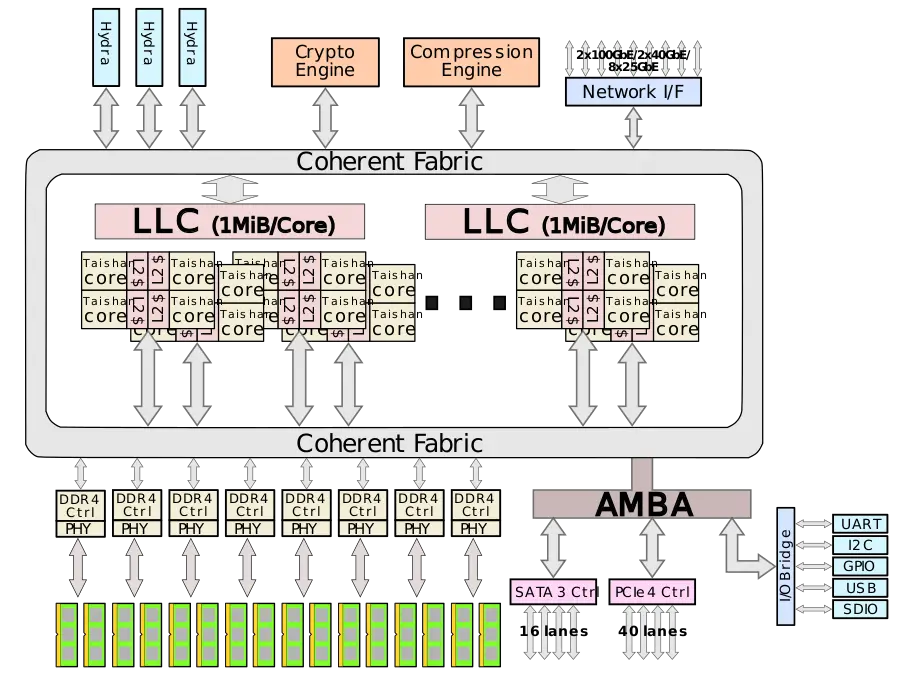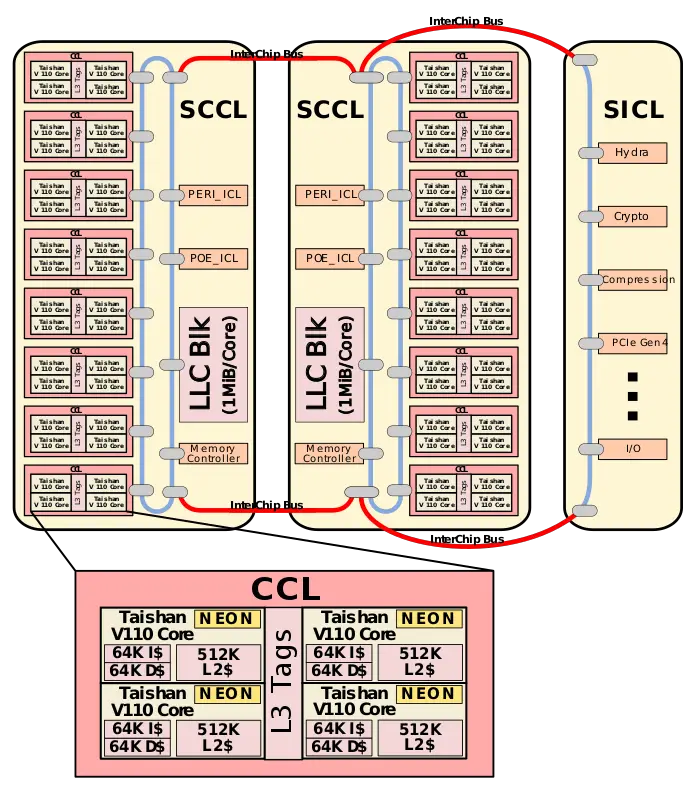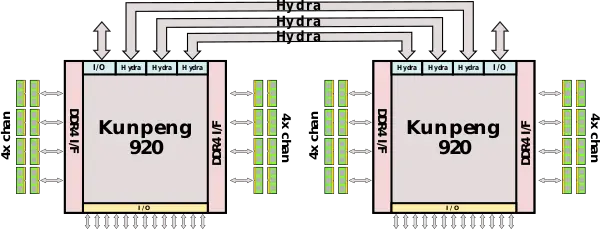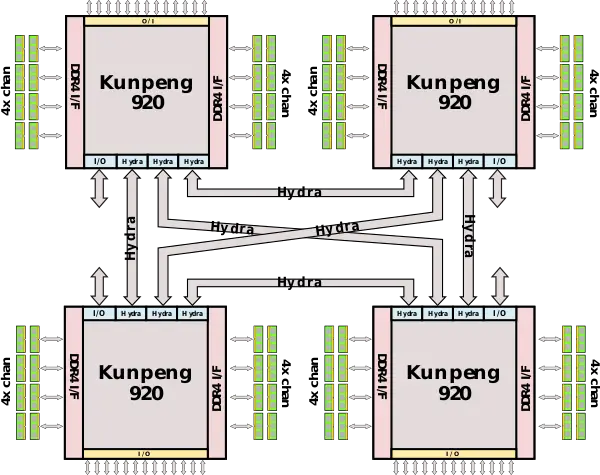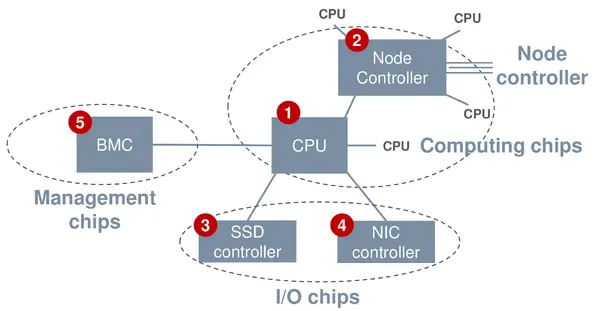[转帖]TaiShan v110 - Microarchitectures - HiSilicon
https://en.wikichip.org/wiki/hisilicon/microarchitectures/taishan_v110
| Edit Values | |
| TaiShan v110 µarch | |
| General Info | |
| Arch Type | CPU |
| Designer | HiSilicon |
| Manufacturer | TSMC |
| Introduction | 2019 |
| Process | 7 nm |
| Core Configs | 32, 48, 64 |
| Pipeline | |
| Type | Superscalar, Superpipeline |
| OoOE | Yes |
| Speculative | Yes |
| Reg Renaming | Yes |
| Decode | 4-way |
| Instructions | |
| ISA | ARMv8.2-A |
| Extensions | NEON |
| Cache | |
| L1I Cache | 64 KiB/core |
| L1D Cache | 64 KiB/core |
| L2 Cache | 512 KiB/core |
| L3 Cache | 1 MiB/core |
| Succession | |
|
|
|
TaiShan v110 is the successor to the TaiShan v100, a high-performance ARM server microarchitecture designed by HiSilicon for Huawei's own TaiShan servers.
contents
[hide]
Brands[edit]
TaiShan-based CPUs are branded as the Kunpeng 920 series.
Release Dates[edit]
Kunpeng 920 CPUs were officially launched in early 2019.
Architecture[edit]
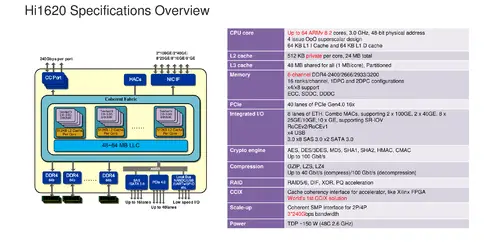
Overview
Key changes from TaiShan v100[edit]
- TSMC 7 nm HPC process (from 16 nm)
- 2x core count (64, up from 32)
- Custom cores (from Cortex-A72)
- ASIMD
- double SP Vector throughput (2 inst/cycle, up from 1)
- ASIMD
- Custom cores (from Cortex-A72)
- Memory
- 2x memory channels (8, up from 4)
- I/O
- PCIe Gen 4 (from Gen 3)
This list is incomplete; you can help by expanding it.
Block Diagram[edit]
Entire Chip[edit]
Memory Hierarchy[edit]
- Cache
- L1I Cache
- 64 KiB/core, private
- 64-byte cache lines
- L1D Cache
- 64 KiB/core, private
- 64-byte cache lines
- L2 Cache
- 512 KiB/core, private
- L3 Cache
- 1 MiB/core
- Shared by all cores
- System DRAM
- 1 TiB Max Memory / socket
- 8 Channels
- DDR4, up to 2933 MT/s
- 1 DPC and 2 DPC support
- 8 B/cycle/channel (@ memory clock)
- ECC, SDDC, DDDC
- L1I Cache
Overview[edit]
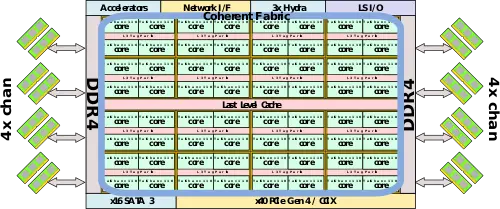
Overview
Though HiSilicon has a history of designing Arm processors. The TaiShan v110 core is HiSilicons' first custom homegrown high-performance ARM core and SoC design. The chip, which incorporates multiple compute dies and an I/O is a multi-chip package, is fabricated on TSMC's 7-nanometers HPC process and integrates up to 64 cores and up to 64 MiB of last level cache.
The SoC also incorporates a number of hardware accelerators. There is a crypto engine that supports AES, DES/3DES, MD5, SHA1, SHA2, HMAC, CMAC with throughputs of up to 100 Gbit/s. Additionally, there is also a compression engine supporting GZIP, LZS, LZ4 with compression throughputs of up to 40 Gbit/s and decompression of up to 100 Gbit/s.
Marketed as the Kunpeng 920, this SoC supports up to 4-way multiprocessing support through HiSilicon's Hydra interface. In order to keep the cores fed, eight DDR4 memory channels are incorporated per socket. Additionally, designed to facilitate an easy accelerator platform, there are 40 PCIe Gen 4 lanes provided per socket with CCIX support, enabling cache coherency.
Core[edit]
Each core is a 4-way out-of-order superscalar that implements the ARMv8.2-A ISA. Huawei stated that the core supports almost all the ARMv8.4 features with a few exceptions, including dot product and the FP16 FML extension. It features private 64 KiB L1 instruction and data caches as well as 512 KiB of private L2. Though light on details, Huawei says that compared to Arm's Cortex cores, their core features an improved memory subsystem, a larger number of execution units, and a better branch predictor.
ASIMD[edit]
Each core features a single 128-bit NEON unit. It is capable of executing single double-precision FMA vector instruction per cycle or two single-precision vector instructions per cycle. Operating at 2 GHz, a 64-core chip will have a peak compute of 512 GigaFLOPS of double-precision floating point. It's worth noting that compared to the TaiShan v100, the throughput for single-precision vector has been doubled from 1 to 2 instructions per cycle.
MCP physical design[edit]
The SoC itself comprises 3 dies - two Super CPU Cluster (SCCL) compute dies and a Super IO Cluster (SICL). The SCCL compute dies contains 8 CPU Clusters (CCLs), memory controllers, and the L3 cache block. There are eight CCLs on each of the SICL dies for a total of 64 cores. The CCLs are TaiShan V110 quadplex along with the L3 cache tags partition. The Super IO Clusters include the various I/O peripherals including PCIe Gen 4, SAS, the network interface controllers, and the Hydra links.
Scalability[edit]
- See also: Hydra Interface
Each chip incorporates three Hydra interface ports. The Hydra interface facilitates the cache coherency between the dies on the chip. Every link supports 240 Gb/s (30 GB/s) of peak bandwidth for a total aggregated bandwidth of 720 Gb/s (90 GB/s) in a 2-way symmetric multiprocessing configuration.
With all three links, there is also support for 4-way SMP. In this configuration, one link from each socket is connected to another socket for an all-for-all connection.
Chipset[edit]
Along with the Hi1620 SoC, HiSilicon developed a number of integrated circuits as part of the chipset platform.
| Chip | Description |
|---|---|
| Hi1620 | CPU, Kunpeng 920 series Chip |
| Hi1503 | CPU interconnect chip, supports scaling-up to 32 sockets |
| Hi1812 | SSD storage controller, for read/write I/O acceleration |
| Hi1822 | Network controller chip, DC high-speed flexible interconnect |
| Hi1710 | BMC management chip + enhanced RAS features chip |
Die[edit]
- TSMC 7 nm HPC
- 20,000,000,000 transistors
- 3-4 dies
All TaiShan v110 Chips[edit]
Bibliography[edit]
- Huawei. Personal Communication. 2019
- Huawei Connect 2018. October 2018
- HiSilicon Event. January 7, 2019
- Huawei, Supercomputing 2018
| codename | TaiShan v110 + |
| core count | 32 +, 48 + and 64 + |
| designer | HiSilicon + |
| first launched | 2019 + |
| full page name | hisilicon/microarchitectures/taishan v110 + |
| instance of | microarchitecture + |
| instruction set architecture | ARMv8.2-A + |
| manufacturer | TSMC + |
| microarchitecture type | CPU + |
| name | TaiShan v110 + |
| process | 7 nm (0.007 μm, 7.0e-6 mm) + |
[转帖]TaiShan v110 - Microarchitectures - HiSilicon的更多相关文章
- 华为TaiShan 2280 ARM 服务器
华为TaiShan 2280 ARM 服务器 华为TaiShan 2280 ARM 服务器 https://e.huawei.com/cn/products/cloud-computing-dc/s ...
- nginx负载均衡基于ip_hash的session粘帖
nginx负载均衡基于ip_hash的session粘帖 nginx可以根据客户端IP进行负载均衡,在upstream里设置ip_hash,就可以针对同一个C类地址段中的客户端选择同一个后端服务器,除 ...
- [转帖]网络协议封封封之Panabit配置文档
原帖地址:http://myhat.blog.51cto.com/391263/322378
- [转帖]零投入用panabit享受万元流控设备——搭建篇
原帖地址:http://net.it168.com/a2009/0505/274/000000274918.shtml 你想合理高效的管理内网流量吗?你想针对各个非法网络应用与服务进行合理限制吗?你是 ...
- 3d数学总结帖
3d数学总结帖,以下是对3d学习过程中数学知识的简单总结 角度值和弧度制的互转 Deg2Rad 角度A1转弧度A2 => A2=A1*PI/180 Rad2Deg 弧度A2转换角度A1 => ...
- [转帖]The Lambda Calculus for Absolute Dummies (like myself)
Monday, May 7, 2012 The Lambda Calculus for Absolute Dummies (like myself) If there is one highly ...
- [转帖]FPGA开发工具汇总
原帖:http://blog.chinaaet.com/yocan/p/5100017074 ----------------------------------------------------- ...
- [Android分享] 【转帖】Android ListView的A-Z字母排序和过滤搜索功能
感谢eoe社区的分享 最近看关于Android实现ListView的功能问题,一直都是小伙伴们关心探讨的Android开发问题之一,今天看到有关ListView实现A-Z字母排序和过滤搜索功能 ...
- AxureRP7.0各类交互效果汇总帖(转)
了便于大家参考,我把这段时间发布分享的所有关于AxureRP7.0的原型做了整理. 以下资源均有对应的RP源文件可以下载. 当然 ,其中有部分是需要通过完成解密游戏[攻略]才能得到下载地址或者下载密码 ...
- 未能加载文件或程序集“Newtonsoft.Json, Version=4.0.0.0, Culture=neutral, PublicKeyToken=30a [问题点数:40分,结帖人u010259408]
未能加载文件或程序集“Newtonsoft.Json, Version=4.0.0.0, Culture=neutral, PublicKeyToken=30a [问题点数:40分,结帖人u01025 ...
随机推荐
- 干货分享丨玩转物联网IoTDA服务系列六-恒温空调
摘要:本文主要讲述空调接入到物联网平台后,通过恒温空调控制系统,不论空调是否开机,都可以调整空调默认温度,待空调上电开机后,自动按默认温度调节. 场景简介 通过恒温控制系统,不论空调是否开机,都可以调 ...
- 【小白学YOLO】一文带你学YOLOv1 Testing
摘要:本文将为初学者带详细分析如何进行YOLOv1 Testing的内容. YOLOv1 Testing 进入testing阶段,我们已经得到98个bounding box和confidence还有C ...
- 华为云PB级数据库GaussDB(for Redis)揭秘第13期:如何搞定推荐系统存储难题
摘要:GaussDB(for Redis)轻松搞定推荐系统核心存储,为企业级应用保驾护航. 本文分享自华为云社区<GaussDB(for Redis)揭秘第13期:如何搞定推荐系统存储难题?&g ...
- 从下个月开始,App Store 要求使用 Xcode 14 构建的 iOS 16 兼容应用程序
Xcode 继向开发者发布第一个iOS 16.5 测试版后,苹果公司周二宣布了对开发者向 App Store 提交应用程序的新要求.从下个月开始,Apple 将要求每个应用程序都必须使用 Xcode ...
- 火山引擎云原生数据仓库 ByteHouse 技术白皮书 V1.0 (Ⅴ)
更多技术交流.求职机会,欢迎关注字节跳动数据平台微信公众号,回复[1]进入官方交流群 近日,<火山引擎云原生数据仓库 ByteHouse 技术白皮书>正式发布.白皮书简述了 ByteHou ...
- 火山引擎 DataTester:“在字节,A/B 实验是一种信仰”
更多技术交流.求职机会,欢迎关注字节跳动数据平台微信公众号,并进入官方交流群 进入数字经济时代,要用数据驱动业务增长已经成为各个行业的共识,但很多企业还没能真正掌握这项能力.如何最大限度转化数据价值, ...
- Solon v2.2.12 发布,Java 应用开发框架
Solon 是一个高效的 Java 应用开发框架:更快.更小.更简单.它不是 Spring.没有使用 Servlet.JavaEE 接口,是一个有自己接口标准的开放生态: 150多个生态插件,可以满足 ...
- Flutter 自定义组件实战之Cupertino(iOS)风格的复选框
继上一篇Flutter自定义组件的视频短课(视频地址: https://www.bilibili.com/video/BV1ap4y1U7UB/ )后,我们继续来聊自定义组件.视频中我为大家详解了Cu ...
- 干掉 LaTeX !用BookDown写本书
Bookdown是著名R包作者谢益辉开发的,支持采用Rmarkdown (R代码可以运行)或普通markdown编写文档,然后编译成HTML, WORD, PDF, Epub等格式. bookdown ...
- MetaGPT day01: MetaGPT作者代码走读、软件公司初始示例
LLM发展历史 - 2013年word2vec提出,但效果不好 - 2017年Transformer结构提出,降低网络复杂度 - 2018年BERT预训练语言模型效果显著提升 - 2019年GPT-3 ...

